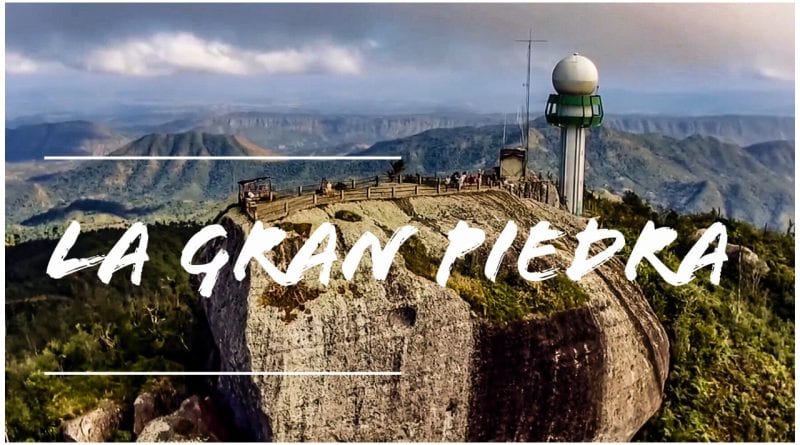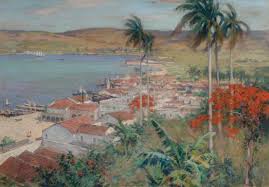SANTIAGO, CUBA: “LA GRAN PIEDRA”, UNA DE LAS ROCAS MÁS ALTAS DEL MUNDO. FOTOS
La Gran Piedra de Cuba es una de las formas en que la naturaleza sorprende constantemente al hombre. Esta piedra “La Gran Roca” es una maravilla de Cuba, siendo a la vez interesante e impresionante.
La Gran Piedra, en Santiago de Cuba, es un accidente geográfico conformado por una enorme piedra de 51 metros de largo, 25 de alto y 30 de ancho. Su peso aproximado es de 70.000 toneladas y actualmente es un popular mirador natural ubicado en lo alto de una montaña.
Esta maravilla de la naturaleza se encuentra a 1.234 metros sobre el nivel del mar y es reconocida mundialmente por su gran tamaño. Se afirma que es considerada la piedra de su tamaño más alta del mundo. Esta roca está situada en la cima de una montaña que se eleva 1.225 metros sobre el nivel del mar. El sitio está ubicado a 25 kilómetros (16 millas) al sureste de la ciudad de Santiago de Cuba.
ORIGEN DE LA GRAN PIEDRA DE SANTIAGO
Las leyendas sobre su origen abarcan desde que se formó con el impacto de un meteorito que cayó a la tierra hace millones de años hasta las que se creen versiones más certeras que consideran su nacimiento por la explosión de un volcán submarino.
Este sitio único ahora está registrado como monumento nacional.
La gigantesca masa pétrea fue quizás testigo del vulcanismo del Paleoceno, como toda la geología de la Sierra Maestra, donde se presentan estratos de este tipo de roca compuestos por capas de lava volcánica. Esta masa es famosa no solo dentro de las fronteras de la isla, sino también en todo el Caribe, ya que es la piedra más grande de toda la región.
Es una torre de vigilancia natural desde donde se puede observar toda la cordillera de la Sierra Maestra; asimismo, desde aquí se divisa casi toda la costa sureste. Los lugareños juran que en una noche clara uno puede incluso ver el brillo de las luces que vienen de la vecina República de Haití.
FLORA Y FAUNA DE “LA GRAN PIEDRA”
En sus alrededores se puede disfrutar de una flora única compuesta por 222 variedades de helechos, así como un total de 352 tipos de orquídeas, eucaliptos, pinos maestrenses, cubenses, cipreses y una variedad de árboles frutales –entre ellos melocotoneros, tan singulares como eso podría parecer.
La fauna de la Gran Piedra es también uno de sus mayores atractivos. Alrededor de la gran masa revolotean pájaros carpinteros, zorzales reales, cartacubas, gavilanes, torcazas y mayas, todos encabezados por nuestra ave nacional: el tocororo.
A sólo medio kilómetro se encuentra el Jardín Botánico de la zona, donde especies como el ave del paraíso, dalias, magnolias y otras flores se crían de manera singular aprovechando el microclima que prevalece en la zona.
La niebla constante y los musgos siempre húmedos que cubren el suelo impregnan el misterio y el enigma de este paraje, cuyas particularidades geomorfológicas, ecológicas, climatológicas y topográficas le otorgan una gran importancia para el turismo ecológico.
Lo más destacado de la visita es la apasionante aventura de subir, envueltos en la densa niebla, los 452 escalones de subida y acompañados de una densa vegetación de helechos y otras especies que perfuman el ambiente.
SANTIAGO, CUBA: “LA GRAN PIEDRA” (The Great Stone), ONE OF THE HIGHEST ROCKS IN THE WORLD. PHOTOS
The Great Stone of Cuba is one of the ways in which nature constantly surprises man. This stone “The Big Rock” is a wonder of Cuba, being both interesting and impressive.
La Gran Piedra, in Santiago de Cuba, is a geographical accident made up of a huge stone 51 meters long, 25 meters high and 30 meters wide. Its approximate weight is 70,000 tons and is currently a popular natural viewpoint located on top of a mountain.
This wonder of nature is located at 1,234 meters above sea level and is recognized worldwide for its large size. It is claimed that it is considered the highest stone of its size in the world. This boulder is situated on the summit of a mountain rising 1,225 meters above sea level. The site is located 25 kilometers (16 miles) southeast from the city of Santiago de Cuba.
ORIGIN OF THE GREAT ROCK OF SANTIAGO
The legends of its origin include everything from it having formed with the impact of a meteorite that fell to the earth millions of years ago to what are believed more accurate versions that consider its birth due to the explosion of an underwater volcano.
This unique site is now registered as a national monument.
The gigantic stone mass was perhaps a witness to the volcanism of the Paleocene, just like all of the geology of the Sierra Maestra Mountains, where strata of this type of rock are present composed of layers of volcanic lava. This mass is famous not only within the frontiers of the island, but also all across the Caribbean since it is the largest such stone in the entire region.
It is a natural watch tower from where the whole mountain range of the Sierra Maestra can be observed; likewise, almost the entire southeastern coast can be seen from here. Locals swear that on a clear night one can even see the gleam of lights coming from the neighboring Republic of Haiti.
FLORA OF “THE GREAT STONE”
In its surroundings one can enjoy unique flora consisting of 222 varieties of ferns, as well as a total of 352 types of orchids, eucalyptuses, maestrense pines, cubenses, cypresses and a variety of fruit-bearing trees –among them peaches, as odd as that might seem.
The fauna of the Gran Piedra is also one of its strongest attractions. Around the great mass flutter carpenter birds, royal thrushes, cartacubas, sparrow hawks, torcazas and mays, all led by our national bird: the tocororo.
Only a half mile away, one can find the area’s Botanical Garden, where species such as the bird of the paradise, dahlias, magnolias and other flowers are raised in a singular manner as they take advantage of the microclimate that prevails in the area.
The constant fog and the ever-damp moss ground-coverings typically pervade the mystery and enigma of this setting, one whose geo-morphological, ecological, climatological and topographical particularities lend it great importance for ecological tourism.
The highlight of the visit is the exciting adventure of climbing, wrapped in the dense fog, 452 steps up and accompanied by a dense vegetation of ferns and other species that perfume the atmosphere.
Agencies/ Wiki/ CubaDime/ Ecured/ Extractors/ Excerpts/ Internet Photos/ Arnoldo Varona/ www.TheCubanhistory.com
THE CUBAN HISTORY, HOLLYWOOD.










